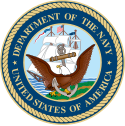Robert Carlisle Giffen
 | |
| Data i miejsce urodzenia | |
|---|---|
| Data i miejsce śmierci | |
| Przebieg służby | |
| Lata służby | 1907–1946 |
| Siły zbrojne | |
| Główne wojny i bitwy | I wojna światowa |
| Odznaczenia | |
Robert Carlisle Giffen (ur. 29 czerwca 1886 w West Chester, zm. 10 grudnia 1962 w Annapolis) – amerykański wojskowy, wiceadmirał United States Navy, uczestnik rejsu Wielkiej Białej Floty oraz obu wojen światowych.
Życiorys
Do Akademii Marynarki Wojennej wstąpił w 1903. Ukończył ją cztery lata później. Otrzymał przydział na pancernik USS „Virginia”, na którym w latach 1907–1909 uczestniczył w wokółziemskim rejsie Wielkiej Białej Floty. Po powrocie służył na pokładach różnych jednostek, był członkiem drużyny strzeleckiej US Navy. W latach 1913–1915 pracował w Washington Navy Yard, następnie służył na niszczycielu USS „Wainwright”.
Po przystąpieniu Stanów Zjednoczonych do działań I wojny światowej dowodził niszczycielem USS „Trippe”, wysłanym na wody europejskie, dołączonym do 6. Dywizjonu Pancerników (6th Battle Squadron) i oddanym pod komendę brytyjską w składzie Grand Fleet. W połowie 1918 objął dowództwo na niszczycielu USS „Schley”, operującym w rejonie Gibraltaru i na Morzu Śródziemnym do sierpnia 1919.
W okresie międzywojennym Robert pełnił różne stanowiska we flocie, zarówno liniowe, jak i sztabowe. Był m.in. wykładowcą w Akademii Marynarki Wojennej, dowódcą kanonierki USS „Sacramento” i lekkiego krążownika USS „Savannah”. W 1940 uzupełniał wykształcenie w Naval War College, później objął stanowisko w Biurze Szefa Operacji Morskich. W marcu 1941 został dowódcą dywizjonu krążowników, uczestniczących w Patrolach Neutralności na Oceanie Atlantyckim.
26 marca 1942, będąc już w randze kontradmirała (Rear Admiral), odpłynął w składzie Task Force 39 do Europy. Następnego dnia, po tragicznej śmierci dowódcy zespołu, kontradmirała Johna Wilcoxa, który wypadł za burtę flagowego pancernika USS „Washington” i zaginął w morzu, jako najstarszy stopniem objął dowodzenie jednostkami, które wkrótce dołączyły do Home Fleet w bazie Scapa Flow[1]. Na czele TF 39 brał udział w operacji „Torch” w Afryce Północnej. W latach 1943–1944 uczestniczył w działaniach na Pacyfiku: bitwie koło wyspy Rennell, walkach o na Aleuty, Wyspy Gilberta i Wyspy Marshalla. W maju 1944 awansował do stopnia wiceadmirała (Vice Admiral) i został dowódcą 10. Dystryktu Morskiego oraz komendantem Caribbean Sea Frontier, z kwaterą główną w San Juan.
Został emerytowany w 1946. Zmarł 10 grudnia 1962 w Annapolis.
Przypisy
- ↑ Winston Jordan, Man Overboard!. usswashington.com. [zarchiwizowane z tego adresu (2012-03-09)]. [dostęp 2011-09-13]
Bibliografia
- Vice Admiral Robert C. Giffen, USN (1886-1962). Naval History and Heritage Command. [dostęp 2011-09-13].
Media użyte na tej stronie
Ribbon for the Asiatic-Pacific Campaign Medal awarded by the United States Department of Defense.
Ribbon for the Navy Cross awarded by the United States Department of the Navy.
Ribbon for the European-African-Middle Eastern Campaign Medal awarded by the United States Department of Defense.
Ribbon for the World War I Victory Medal awarded by the Allies:
- w:World War I Victory Medal (United States) awarded by the w:United States Department of Defense
- w:Victory Medal (United Kingdom) also called the Inter-Allied Victory Medal
- w:Médaille Interalliée 1914–1918 (France)
- w:Inter-Allied Victory Medal (Greece)
- w:Allied Victory Medal (Italy)
- etc.
Naramiennik stopnia Vice Admiral (United States Navy).
Ribbon for the Navy Distinguished Service Medal awarded by the United States Department of the Navy.
*Description: On a circular background of fair sky and moderate sea with land in sinister base, a tri-mast square rigged ship under way before a fair breeze with after top-sail furled, commission pennant atop the foremast, National Ensign atop the main, and the commodore's flag atop the mizzen. In front of the ship a luce-type anchor inclined slightly bendwise with the crown resting on the land and, in front of the shank and in back of the dexter fluke, an American bald eagle rising to sinister regarding to dexter, one foot on the ground, the other resting on the anchor near the shank; all in proper colors. The whole within a blue annulet bearing the inscription "Department of the Navy" at the top and "United States of America" at the bottom, separated on each side by a mullet and within a rim in the form of a rope; inscription, rope, mullet, and edges of annulet all gold. *Background: The policy for use of the Navy seal and emblem is contained in SECNAV Instr 5030.4 and SECNAV Instr 5030.6. The seal design was approved by the President of the United States by Executive Order 10736 dated October 23, 1957. Request for use of the Navy emblem should be submitted in writing to Defense Printing Service, ATTN: DPSMO, 8725 John Kingman Rd Suite 3239, Fort Belvoir, VA 22060-6220. The telephone number is (703) 767-4218. 1879 version here: http://etc.usf.edu/clipart/54900/54985/54985_seal_navy.htm
Ribbon for the American Campaign Medal awarded by the United States Department of Defense.
Vice Admiral Robert C. Giffen, USN Photographed during World War II. The original print bears a date of 27 December 1950, which is probably when it was received by the Naval Photographic Center.
Ribbon for the World War II Victory Medal awarded by the United States Department of Defense.









